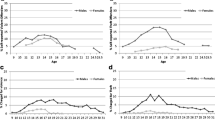The National Crime Victimization Survey has been informed by decades of methodological research on the measurement of victimization. Yet most criminologists have little knowledge of the process or outcomes of this research or its effects on the characteristics of the survey. Using in-house reports, conference papers, agency memoranda, and other documents, this paper describes some of the important methodological research that has taken place since the 1992 redesign of the survey. Much of the more recent research is the consequence of new initiatives for the survey, such as the measurement of hate crime victimization and victimization among the developmentally disabled, as well as periodic supplements. This research finds that the current characteristics of the NCVS reflect decisions made on the basis of methodological research, broader social and political factors, and budgetary constraints.
Similar content being viewed by others
References
B. K. Atrostic N. Bates G. Burt A. Silberstein (2001) ArticleTitleNonresponse in U.S. government household surveys: consistent measures, recent trends, and new insights J. Off. Stat 17 209–226
J. Best (2001) Damned Lies and Statistics: Untangling Numbers from the Media, Politicians, and Activists University of California Press Berkeley, CA
InstitutionalAuthorNameBureau of Justice Statistics (2002) Strategic Plan U.S. Department of Justice Washington, D.C
InstitutionalAuthorNameBureau of Justice Statistics (2003) Criminal Victimization in the United States, 2002 U.S. Department of Justice Washington, D.C
A. Biderman J. Lynch (1991) Understanding Crime Incidence Statistics: Why the UCR Diverges From the NCS Springer-Verlag New York
R. Groves M. Couper (1998) Nonresponse in Household Interview Surveys Wiley New York
V. Jenness K. Broad (1997) Hate Crimes: New Social Movements and the Politics of Violence Aldine De Gruyter New York
V. Jenness R. Grattet (2001) Making a Hate Crime: From Social Movement to Law Enforcement Russell Sage New York
C. Kindermann J. Lynch D. Cantor (1997) Effects of the Redesign on Victimization Estimates, Bureau of Justice Statistics U.S. Department of Justice Washington, DC
Laskey, C. (2002). Chronology of the national crime victimization survey – 1969 and beyond, in-house document, U.S. Census Bureau
Lee, M., Lewis, D., Crowley, M., Hock, E., Laskey, C., Loftin, C., Logan, W., and Addington L. (1999). Developing hate crime questions for the national crime victimization survey, pp. 1036–1041. In Proceedings of the American Statistical Association, Survey Research Methods Section
R. Lehnen W. Skogan (Eds) (1981) The National Crime Survey Working Papers, Current and Historical Perspectives NumberInSeriesVol. I USGPO Washington DC
R., and Lehnen W. Skogan (Eds) (1984) The National Crime Survey Working Papers, Vol. II: Methodological Studies, Bureau of Justice Statistics U.S. Department of Justice Washington DC
Lewis, D. (2002a). NCVS research: memorandum no. 02–02, NCVS Research Unit, Demographic Surveys Division, U.S. Census Bureau. Memorandum dated June, 2002
Lewis, D. (2002b). NCVS research: memorandum no. 02–09, NCVS Research Unit, Demographic Surveys Division, U.S. Census Bureau. Memorandum dated November, 2002
M. Maltz M. Zawitz (1998) Displaying Violent Crime Trends, Bureau of Justice Statistics U.S. Department of Justice Washington, DC
R. O’Brien (1985) Crime and Victimization Data Sage Beverly Hills
B., and Penick M. Owens (Eds) (1976) Surveying Crime National Academy of Sciences Washington DC
M. Rand (2000) The victimization of people with disabilities study, in-house research proposal, Bureau of Justice Statistics U.S. Department of Justice Washington, DC
Rand, M. (2004). Personal communication with Michael Rand, Chief of Victimization Statistics, Bureau of Justice Statistics, U.S. Department of Justice, February
M. Rand J. Lynch D. Cantor (1997) Criminal Victimization, 1973–1995, Bureau of Justice Statistics U.S. Department of Justice Washington, DC
C. Rennison M. Rand (2003) Criminal Victimization, 2002, Bureau of Justice Statistics U.S. Department of Justice Washington, DC
B. Taylor (1989) Redesign of the National Crime Survey: Special Report, Bureau of Justice Statistics U.S. Department of Justice Washington, DC
Author information
Authors and Affiliations
Corresponding author
Rights and permissions
About this article
Cite this article
Lauritsen, J.L. Social and Scientific Influences on the Measurement of Criminal Victimization. J Quant Criminol 21, 245–266 (2005). https://doi.org/10.1007/s10940-005-4271-8
Issue Date:
DOI: https://doi.org/10.1007/s10940-005-4271-8




